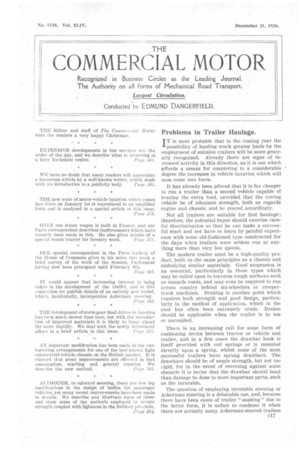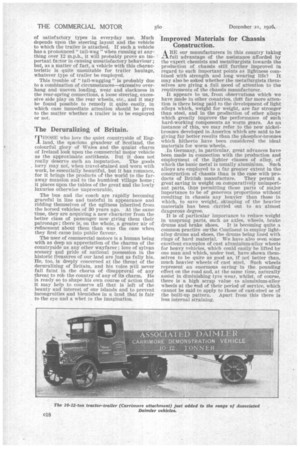Problems in Trailer Haulage.
Page 39

Page 40

If you've noticed an error in this article please click here to report it so we can fix it.
T T is most probable that in the coming year the -I-possibility of hauling much greater loads by the employment of suitable trailers will be more generally. recognized. Already there are signs of increased activity in this direction, as it is one which affords a means for countering to a considerable degree the increases in vehicle taxation which will soon come into force.
It has already been peoVed that it is far cheaper to run a trailer than a second vehicle capable of bearing the extra load, provided that the towing_ vehicle be of adequate .strength, both as regards engine and. chassis, and be geared accordingly.
Not all trailers are suitable for fast haulage ; therefore, the potential buyer should exercise careful discrimination so that he can make a successful start and not have to learn by painful experience with some old-fashioned type constructed for the days when trailers were seldom run at anything more than very low speeds.
The modern trailer must be a high-quality product, built on the same principles as a chassis and embodying similar materials. Good suspension is an essential, particularly in those types which may be called upon to traverse rough surfaces such as untnade roads, and may even be required to run across country behind six-wheelers Or creepertt ack machines. Braking is another point which requires both .strength and good design, particularly in the method of application, which in the past has often been extremely crude. Brakes should be applicable when the trailer is in use or uncouPIed.
Thefe is an increasing call for some form of cushioning device between tractor or vehicle and trailer, and in a few cases the drawbar hook is itself provided with coil springs or is mounted directly upon a spring, whilst some a the most successful trailers have sprung drawbars. The drawbars should be of ample strength, but not too rigid, for in the event of reversing against some obstacle it is better that the drawbar should bend than damage be done to more important parts, such as the turntable.
The question of employing turntable steering or Ackerman steering is a debatable one, and, because there have been cases of trailer " snaking " due to the latter form, it is unfair to condemn it when there are actually many Ackerman-steered trailers of satisfactory types in everyday use. Much depends upon the steering layout and the vehicle to which the trailer is attached. If such n vehicle has a pronounced" tail-wag" when running at anything over 12 m.p.h., it will probably prove an important factor in causing unsatisfactory behaviour ; but, as a matter of fact, a vehicle with this characteristic is quite uusuitable for trailer haulage, whatever type of trailer be employed.
This trouble of " tail-wagging " is probably due to a combination of circumstances—excessive overhang and uneven loading, wear and slackness in the rear-spring connections, a loose steering, excessive side play on the rear wheels, etc., and it may be found possible to remedy it quite easily, in which case immediate attention should be given to the matter whether a trailer is to be employed or not.
The Deruralizing of Britain.
rr imSE who love the quiet countryside of Eng land, the spacious grandeur of Scotland, the colourful glory of Wales and the quaint charm of Ireland look upon the commercial motor vehicle as the approximate antithesis. But it does not really deserve such an imputation. The goods lorry may not, when travel-stained and worn with work, be essentially beautiful, but it has romance, for it brings the products of the world to the faraway mansion and to the humblest village home; it places upon the tables of the great and the lowly luxuries otherwise unprocurable.
The bus and the coach are rapidly becoming graceful in line and tasteful in appearance and ridding themselves of the ugliness inherited from the horsed vehicles of 30 years ago. At the same time, they are acquiring a new character from the better class of passenger now giving them their patronage; there is, on the whole, a greater air of refinement about them than was the case when they first came into public favour.
The user of commercial motors is a human being with as deep an appreciation of the charms of the countryside as any other wayfarer ; love of sylvan scenery and pride of national possession in the historic freasures of our land are Just as fully his. He, too, is deeply concerned at the threat of the deruralizing of Britain, and his voice will never fall faint hi the chorus of disapproval of any threat to rob the country of any of its charm. He is ready so to shape his own course of action that It may help to conserve all that is left of the beauty and interest of our islands and to prevent Incongruities and blemishes hi a land that is fair to the eye and a whet to the imagination.
Improved Materials for Chassis Construction.
A RE our manufacturers in this country taking full advantage of the assistance afforded by the expert chemists and metallurgists towards the production of chassis still further improved in regard to such important points as lightness combined with strength and long wearing life? It may also be asked whether the metallurgists themselves are giving a full meed of attention to the requirements of the chassis manufacturer.
It appears to us, from observations which we have inade in other countries, that far more attention is there being paid to the development of light alloys which, weight for weight, are far stronger than steel, and in the production of other alloys which greatly improve the performance of such hard-working components as worm gears. As an. instance of this, we may refer to the new nickelbronzes developed in America which are said to be giving far better results than the phosphor-bronzes which hitherto have been considered the ideal materials for worm wheels.
In Germany, in particular, great advances have been made in connection with the production and employment of the lighter classes of alloy, of which the basic metal is usually aluminium. Such alloys are employed to a far greater extent in the construction of chassis than is the case with products of British manufacture. They permit a great saving in weight on comparatively unimportant parts, thus permitting those parts of major importance to be of generous proportions without resulting in chassis any heavier than those in which, to save weight, skimping of the heavier materials has been carried out to an almost dangerous degree.
It is of particular importance to reduce weight in unsprung parts, such as axles, wheels, brake drums and brake shoes. It is becoming quite a common practice oirthe Continent to employ lightalloy drums and shoes, the drums being lined with rings of hard material. We have also seen some excellent examples of cast aluminium-alloy wheels for heavy vehicles, which could easily he lifted by one man and which, under test, have shown themselves to be quite as good as, if not better than, much heavier wheels of cast steel. Such wheels represent an enormous saving in the pounding effect on the road and, at the same time, naturally assist in diminishing tyre wear, whilst, of course, there is a high scrap .value to aluminium-alloy wheels at the end of their period of service, which cannot be said to apply to those of cast-steel or of the built-up pattern. Apart from this there is less internal straining.












































































































